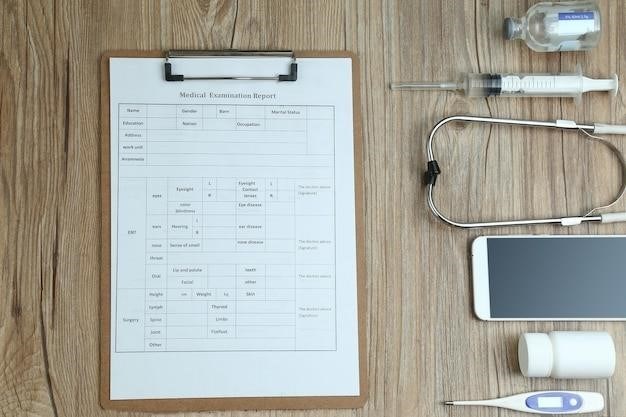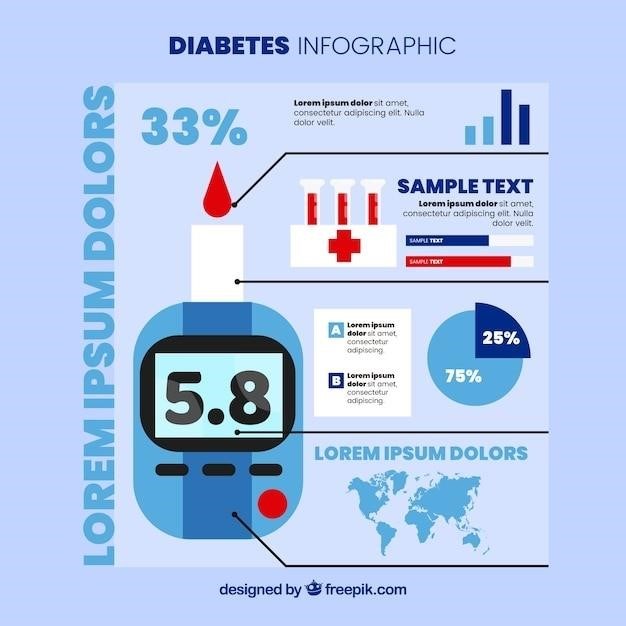Importance of Blood Glucose Monitoring
Regular blood glucose monitoring is crucial for managing diabetes and preventing complications․ Tracking blood sugar levels helps individuals understand how food, activity, and medication affect their bodies, enabling better health management and informed decisions․
Why Monitor Blood Glucose?
Monitoring blood glucose levels is paramount for individuals with diabetes to maintain optimal health and prevent serious complications․ Regular testing provides valuable insights into how various factors influence blood sugar, such as meals, physical activity, and medication․ This knowledge empowers individuals to make informed adjustments to their lifestyle and treatment plans, thereby preventing both short-term and long-term health risks․ Consistent monitoring allows for early detection of potentially dangerous fluctuations, enabling prompt intervention to prevent hypoglycemia (low blood sugar) or hyperglycemia (high blood sugar)․ By closely tracking blood sugar trends, individuals and healthcare providers can collaboratively fine-tune diabetes management strategies, leading to improved overall well-being and quality of life․ The data gathered is also essential for evaluating the effectiveness of treatment regimens and making necessary modifications for better glucose control․ Ultimately, consistent blood glucose monitoring is a cornerstone of effective diabetes management․ Printable blood glucose charts facilitate this process, providing a convenient and organized system for recording and tracking daily readings․
Factors Influencing Blood Glucose Levels
Numerous factors intricately influence blood glucose levels, making consistent monitoring essential for effective diabetes management․ Dietary choices significantly impact blood sugar; carbohydrate intake, in particular, plays a crucial role․ The type of carbohydrate (simple vs․ complex) and the portion size directly affect the rate and extent of blood glucose elevation․ Physical activity helps regulate blood sugar by increasing insulin sensitivity and promoting glucose uptake by muscles․ Medication, including insulin and oral hypoglycemic agents, is a key determinant of blood glucose levels; proper dosage and timing are critical for maintaining stable blood sugar․ Stress hormones released during stressful situations can raise blood sugar levels, highlighting the importance of stress management techniques․ Illness and infections can also disrupt blood glucose control, necessitating close monitoring and potential adjustments to treatment․ Sleep quality and quantity influence insulin sensitivity, impacting blood sugar regulation․ Finally, individual genetics play a role in determining how the body processes glucose, influencing the response to dietary changes and medication․

Printable Blood Glucose Charts
Downloadable blood glucose charts offer a convenient method for tracking blood sugar levels․ These printable templates help individuals monitor their glucose readings efficiently, facilitating better diabetes management․
Downloadable Templates
Many websites offer free printable blood glucose charts in PDF format․ These templates are readily available online and can be easily downloaded․ The design varies; some provide simple spaces to record daily readings, while others incorporate features for insulin tracking or additional notes․ Users can select a chart style that suits their needs and preferences․ The convenience of printing these charts eliminates the need for purchasing specialized diabetes journals․ After downloading, individuals can print as many copies as necessary․ This accessibility makes consistent blood glucose monitoring more manageable and affordable․
Features of Printable Charts
Printable blood glucose charts offer various features to enhance their usability․ Many include columns for recording date, time, blood glucose level, and any relevant notes, such as meals eaten or physical activity levels․ Some charts provide space for insulin dosages, both before and after meals․ The inclusion of weekly or monthly summaries allows for easy identification of trends and patterns in blood glucose levels․ Color-coding or visual aids can highlight important data, such as high or low readings․ Furthermore, some advanced templates may include sections for HbA1c values or other relevant health data․ The customizable nature of these charts allows users to tailor them to their individual needs and tracking preferences, improving the overall management of their diabetes․

Interpreting Blood Glucose Readings
Understanding blood glucose readings is vital for effective diabetes management․ Knowing normal and abnormal ranges allows for timely adjustments to treatment plans, preventing complications․
Normal and Abnormal Ranges
Normal blood glucose levels vary depending on the time of day and individual factors․ Generally, fasting blood sugar (before eating) should be between 70 and 100 mg/dL (3․9-5․6 mmol/L)․ Two hours after a meal, levels should ideally be under 140 mg/dL (7․8 mmol/L)․ Higher levels consistently indicate hyperglycemia, a hallmark of diabetes․ Conversely, consistently low levels (hypoglycemia) are dangerous and may cause symptoms like dizziness, sweating, and confusion․ The specific target ranges vary based on individual health, treatment plans, and doctor recommendations․ Regular monitoring helps identify trends, enabling proactive adjustments to diet, exercise, and medication to maintain optimal blood sugar levels․ Individuals should consult their healthcare provider to determine their personal target ranges and understand the significance of their readings․ A printable blood glucose chart can facilitate this process, providing a clear visual record of daily fluctuations․
Relationship to HbA1c
While daily blood glucose readings provide a snapshot of current sugar levels, HbA1c offers a broader picture of long-term glucose control․ HbA1c, or glycosylated hemoglobin, measures the average blood sugar level over the past two to three months․ It reflects the percentage of hemoglobin in red blood cells that has glucose attached․ A higher HbA1c indicates poorer long-term glucose control, increasing the risk of diabetes complications․ Regular HbA1c tests are essential for diabetes management, complementing daily blood glucose monitoring․ Using both HbA1c and daily blood glucose readings allows healthcare professionals to assess overall diabetes control and adjust treatment accordingly․ A printable chart can help track both daily blood sugar and HbA1c results over time, creating a comprehensive record for doctor visits․ This integrated approach enhances the effectiveness of diabetes management strategies, ultimately improving patient outcomes and reducing long-term health risks․
Managing Blood Glucose
Effective blood glucose management involves a balanced approach encompassing dietary adjustments, regular physical activity, and consistent medication adherence, if prescribed․
Dietary Considerations
Dietary choices significantly influence blood glucose levels․ Prioritizing foods with low glycemic indexes (GI) is crucial․ These foods cause slower, more gradual rises in blood sugar compared to high-GI foods․ Focus on incorporating plenty of non-starchy vegetables, lean proteins, and whole grains into your meals․ Fruits, while healthy, should be consumed in moderation due to their natural sugar content․ Portion control is also vital; even low-GI foods can elevate blood sugar if eaten in excessive amounts․ Regular meal timing helps maintain stable blood glucose levels throughout the day, preventing drastic spikes and drops․ Consulting a registered dietitian or certified diabetes educator can provide personalized dietary guidance tailored to your individual needs and health goals․ They can help you create a meal plan that effectively manages your blood sugar while ensuring adequate nutrient intake․
Physical Activity and Blood Sugar
Regular physical activity plays a vital role in managing blood glucose levels․ Exercise helps your body use insulin more effectively, improving glucose uptake from the bloodstream into cells․ This leads to lower blood sugar levels․ The type, intensity, and duration of exercise all impact blood sugar control․ Moderate-intensity activities like brisk walking, swimming, or cycling are generally recommended․ Before starting any new exercise program, especially if you have diabetes, consult your doctor or a qualified healthcare professional․ They can help you develop a safe and effective exercise plan tailored to your individual needs and health status․ Remember to monitor your blood glucose levels before, during, and after exercise, as physical activity can sometimes cause temporary fluctuations․ Always carry a source of readily available glucose, such as glucose tablets or juice, in case of hypoglycemia (low blood sugar)․